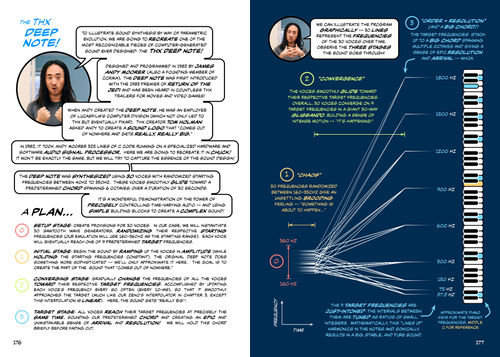220b-winter-2024/hw1
Appearance
Homework #1: ChucKus and Sound Logo
Due Date
- parts 1 + 2 on web portfolio + uploaded to canvas: 2024.1.16 11:59:59pm, Tuesday
- in-class presentation of sound logo: 2024.1.17, Wednesday
Part 1: ChucKus
- construct two chuckus, according to the following specifications:
- like a haiku, a chucku should contain exactly 3 lines of code (each less than 80 characters)
- each chucku should generate sound
- 5/7/5 pattern optional; do attend to the structural aesthetics of the code
- check out one line chuck crazy to see similarly compact examples
- the chuckus should be standalone (i.e., no external audio or chuck files)
- (thanks to Chris + kijjaz for the idea)
Part 2: Design Your Sound Logo
- read "Design of the THX Deep Note" from Artful Design
- additional resources (code, score, Andy's personal account): THX Deep Note
- full instructions: Design Etude #4 from Artful Design
- design and create, using ChucK, your own sound logo
- 30 seconds in duration
- figure out what you are designing the logo for?
- CCRMA?
- yourself??
- your cat???
- an organization you belong to????
- ???
- have a narrative (e.g., beginning, middle, end—or...)
- make it interesting
- experiment with have MANY INSTANCES (e.g., like saw voices in the THX Deep Note) that are both independently controlled but also obey an overall plan
- reference "A Few (Programmable) Parameters of Musical Sound" for ideas; you don't have use all of these, but do consider these
- have fun with it!
Part 3: Set up your web portfolio
- if you don't have one yet, create a CCRMA account
- read "Setting up your CCRMA homepage/220b website"
- your web portfolio should live at https://ccrma.stanford.edu/~YOURID/220b/
Deliverables
turn in all files by putting them in your 220b CCRMA web portfolio AND to Canvas (you will need a CCRMA account for this!)
- 1) this homework should live at https://ccrma.stanford.edu/~YOURID/220b/hw1
- 2) a separate .ck file for each chucku
- 3) title + clear description of the sound logo, who/what it's for, and how you deployed it
- 4) your .ck file(s) for your sound logo
- 5) an audio recording of your sound logo (e.g., hw1.mp3)
- 6) a short README text (readme.txt) file that:
- conveys your ideas/comments in constructing each program
- contains instructions on running your programs
- describes any difficulties you encountered in the process
